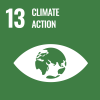Oromia Region, 13 February 2023 – In Oromia, tucked in the southern region of Ethiopia, 63-year-old Boneya watches as his children play with toys crafted from dried leaves and sticks.
“I can’t believe we’ve been here for three years now. This is the life my children know,” he says.
Seven years ago, his hometown of Moyale, close to the Kenyan border, was engulfed in intercommunal conflict, pushing them to flee some 37 kilometers into Oromia. Since then, they have been living in a makeshift tent they constructed using local materials.
Being displaced had its challenges, but this worsened for the father of 13 since the drought hit the region. More than half a million people were displaced by what is now the worst drought to ever hit the country in the past 40 years. Living in a makeshift shelter has made their situation even more unbearable, worsening the living conditions for Boneya and his family.

Boneya fled his home together with his 13 children and has been grappling with the effects of drought. Photo: IOM/Kaye Viray
“During the mornings and afternoons, the extreme heat, the scorching sun, the dryness, and everything in between has made it impossible to live like normal persons. In the evening, the cold bites, making it hard for us, especially the kids, to sleep,” he shares.
Many regions in Ethiopia are in the grip of a severe La Niña-induced drought that has impacted neighbouring countries, including Somalia, leaving millions in need of food assistance, livestock dead and people’s livelihoods destroyed. This has pushed hundreds of thousands of drought-affected people to migrate in search of water, pasture, or assistance.
For large families like Boneya’s, having a place to shelter from the harsh weather patterns is key to coping with the effects. For Boneya, it is one less problem to worry about.

Boneya and his family were living in a dome-shaped makeshift hut where they were exposed to the scorching sun during the day and biting cold in the evening. Photo: IOM/Kaye Viray
“I know this home will help my family. Now, our living conditions are a lot better, and it is one less problem to worry about for the family. We look forward to moving on and continuing our lives despite this drought,” Boneya said.
In three villages in Moyale district and Borena zone, IOM is constructing, repairing, and maintaining household and communal shelters to help the community cope with the extreme temperatures in addition to providing non-food household items including blankets, water buckets, and basic household needs like cooking materials, to the crisis-affected populations across these drought-affected regions.
IOM is also providing cash assistance for shelter, non-food items and other needs to support results that go beyond humanitarian priorities, and which can contribute to long-term development processes.

Now, the family has built a house using locally sourced materials and cash support from IOM. Photo: IOM/ Kaye Viray
More than 39,500 drought-affected people including Boneya and his family have been supported with shelter, cash assistance to support with the shelter needs, access to clean water and non-food items.
IOM is using a variety of approaches to support those in need of shelter to tailor the response to the context on the ground, while considering the availability of local materials in different regions of Ethiopia which have different weather conditions.
Coordination with other actors ensures a multisectoral response and addresses multiple needs of communities affected by emergencies. This way, families like Boneya’s are given the support they need to get back on their feet after suffering from such shocks.

Boneya’s wife and youngest child smiling next to their new home. Photo: IOM/Kaye Viray
Through a capacity-building initiative by IOM, local carpenters are trained on quality standards to ensure the delivery of good-quality and durable houses as part of the Sendai Framework priority area of ‘building back better’. Integrating humanitarian assistance with community participation and technical support results in sustainable solutions ensuring that people like Boneya have safer homes for a long time.
Continued failed rainy seasons in southern and eastern Ethiopia since 2020 have affected 24 million people living in the affected areas with over 4.5 million livestock dying, hence impacting livelihoods of most of the communities that are reliant on pastoralism. Over half a million people have been displaced due to drought. IOM in Ethiopia is scaling up humanitarian response to provide much-needed assistance. Simultaneous interventions are required to recover from and build resilience to severe climatic shocks.
IOM’s Shelter Support in drought-affected regions of Ethiopia is supported by USAID, Shelterbox, Ethiopia Humanitarian Fund (EHF) and Japan’s Supplementary Budget.
This story is written by Kaye Viray, Media and Communications Officer, IOM Ethiopia.



